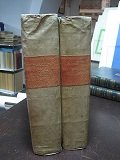2 volumi in-4° grande (325x230mm), pp. XXXI, 572, (4) con errata finale; (4), 660, (4) con errata finale; solida legatura coeva m. pergamena con titolo e fregi in oro su tasselli in pelle arancio ai dorsi. Piatti cartonati. Al primo vol., una carta del Sud America ripiegata, un ritratto del Robertson all'antiporta e una carta ripiegata del Golfo del Messico, con parte dei Caraibi e del Centro America, il tutto inciso su rame; al secondo vol., una 'Carta dei Paesi sopra il Mare Meridionale da Panama a Guayquil' ripiegata, una carta del Messico anch'essa ripiegata e una tavola f.t. riproducente pittogrammi di popoli precolombiani, il tutto inciso su rame. Le carte sono disegnate da Tomhas Kitchin, Idrografo di Sua Maesta Britannica, ed incise dal lucchese Bartolomeo Nerici. Alcuni aloni ai piatti. Candido esemplare a pieni margini e in barbe, impresso su carta forte. Una delle prime edizioni italiane, splendidamente impressa, di una delle più cospicue opere storiografiche del Robertson, la 'History of the Discovery and Settlement of America' (1777), forse il più importante studio settecentesco sulle vicende storiche del Centro e del Sud America. 'Its vivid descriptions and philosophical disquisitions on aboriginal society captivated the literary world, while the outbreak of the American war lent the book pertinent public interest and rendered it more popular than either of its predecessors. Keats, who read it with enthusiasm many years after, owed to it the suggestion of his famous simile of 'Cortez and his men' (Dictionary of National Biography). L'opera, fondata su un giudizio sostanzialmente positivo in merito alla colonizzazione spagnola dell'America Centrale e Meridionale, fu elogiata al suo apparire dalla Edinburgh Review come 'abounding in the finest descriptions, the most pleasing delineations of character, the most dignified and judicious mixture of reflections. the full flow of his narration. will render his works immortal in the hands of the bulk of mankind'. Un giudizio entusiastico fu espresso anche da Walpole, sorpreso che un uomo come Robertson avesse potuto comporre 'what all the world now allows to be the best modern history' e potesse scrivere 'in the purest English and with as much seeming knowledge of men and courts as if he had passed all his life in important embassies.' La ricca documentazione, spesso attinta a fonti prima inaccessibili, fu possibile anche grazie ad informazioni che pervennero al Robertson da Bougainville, da La Condamine, dal Governatore del Massachussets Hutchinson, nonché da regnanti come Maria Teresa e Caterina II di Russia. Il Robertson (Borthwick, Scozia, 1721-Grange House, Edimburgo, 1793), ministro presbiteriano e predicatore in gioventù, nel 1745 si aggregò ai volontari decisi ad impedire l'invasione e l'avvento al trono inglese di Charles Edward Stuart. Tra le sue opere, tutte fondate su serie ricerche archivistiche e su equilibrati giudizi, che per tono e spirito lo fecero considerare un David Hume della storiografia: 'The History of the Reign of the Emperor Charles V', 'Historical Disquisition concerning the Knowledge which the Ancients had of India', 'View of the Progress of the Society in Europe from the Subversion of Roman Empire to the beginning of the sixteenth Century'. Cfr. (edizione inglese) Palau, 271017. Sabin, 71973. Howes, R-358. Lownder, III, 2107. Cox, II, 150. Dictionary of National Biography, XVI, 1314. Brunet, IV, 1332. Graesse, VI, 138. Larned, 403. Hill, Pacific Voyages, 254-55.


Find out how to use
Find out how to use

